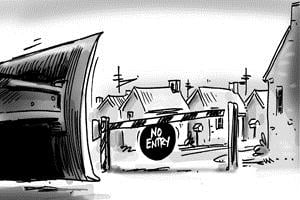In the debate about future urban growth, land use zoning has an important role as a policy tool that can assist in achieving desirable outcomes; however, zoning should be much more flexible and less prescriptive. Currently, in our growth areas, land zoning encourages highly segregated land uses with very homogenous neighbourhoods, providing limited opportunity to diversify residential stock in the future. The prescriptive nature of many of these zones together with the difficulty involved in changing an area’s zoning seems designed to preserve the current urban environment in perpetuity, rather than recognising that areas will be required to change and adapt if they are to remain desirable places to live in the future.

I have previously blogged about the need for neighbourhoods to be flexible in terms of land use and building type so as to be able to adapt to the changing needs of a population (read my previous blog here). An extremely good summary of the many barriers to future adaptability is a report published by the Grattan Institute, published in September 2012 . In particular, it focuses on the growth areas around Australian major cities, and the difficulties that they will face in future years as their populations become more diverse with a mismatch between housing stock and housing need.
Within Australian cities are a number of neighbourhoods that have proved very successful in diversifying housing types and land use. Established inner city suburbs have undergone a demographic changes and regeneration, and have proved remarkably resilient. Many such neighbourhoods are remarkably adaptable to changing needs, containing a highly diverse housing stock, whilst maintaining a diversity of land uses. Areas such as Collingwood, in Melbourne, provide a varied housing stock, together with shopping and commercial strips, and spaces used for commercial office space and manufacturing. These last factors are important. In the many debates about the planning of new neighborhoods, strictly segregated land use has been considered best practice, with industrial, commercial and employment zones being segregated from residential. Although it is of course desirable to segregate particular activities that have an untoward effect on neighbouring areas, whether through noise, pollution, smells, or traffic etc, it is not the case that all manufacturing or commercial activities require segregation.
Areas such as Carlton and Collingwood have a large number of older industrial type buildings that have diversified in their use. These buildings are generally on large lots, which have allowed large scale redevelopment for residential, or a number of other alternative uses. Few maintain their original use, instead providing space for small businesses undertaking a range of activities, from mechanics to architects, community organisations, and joinery and metal workshops to information technology businesses. Many such businesses are too small to afford rents within the CBD, need to be readily accessible to a varied client base, or require a location close to other linkage industries and retail outlets. These areas also have thriving shopping streets, providing space for a number of entrepreneurs to set up a variety of outlets, in contrast to the box type shopping centres within many growth areas which are dominated by large retail outlets with limited space suitable for small businesses.
The variety of uses within inner city neighbourhoods have proved key to ensuring their adaptability to the changing needs of their population. Agreed, there are a number of inner neighbourhoods that are anything but fashionable, such as Sunshine, in Melbourne’s western suburbs, but these are the areas most likely to undergo regeneration in the near future, having a range of land uses and lot sizes that can accommodate redevelopment, meet future infrastructure demands, or provide alternative uses, such as offices, as demand requires. This contrasts with the land use policies in many of the growth areas, which are highly prescriptive about what can be done in a particular area, particularly those zoned residential, with set housing densities, building heights and land use. Whilst land use zoning protects against undesirable outcomes and provides a degree of certainty, especially for residents, it is often overly rigid and protects the status quo at the expense of future adaptability. The exclusionary nature of zoning has a catch-all quality, and does not discriminate between beneficial and undesirable outcomes. Furthermore, zoning has become ever more complicated and is extremely difficult to change, requiring a daunting number of procedural and bureaucratic steps, as well as being a prohibitively expensive and lengthy process. The danger is that, in new growth areas, current zoning will still be in place even when the area’s role and function has completely changed.









